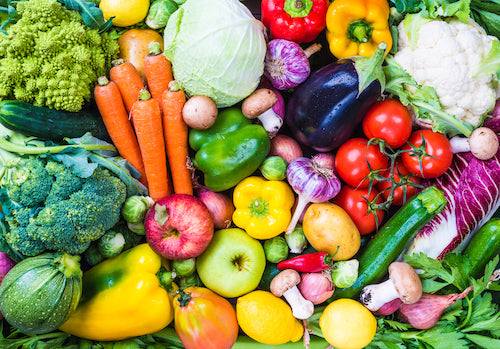June 14, 2016
6 Shopping Tips to Make Your Life Easier
 The trick to saving money and losing weight is to first learn how to fill your shopping cart the right way. Your kitchen also acts as your gym so it's important to make sure you shop smart and have the right foods to get healthy and reach your goals. The food you eat has the biggest impact on your health, body weight, and wallet. Let's learn how to correctly use the grocery store while saving money, calories, and improving your time management - all without breaking a sweat!
You'll want to get familiar with your local grocery stores. Compare prices and what your best options are. You may be bouncing back and forth from different stores for certain items, so don't be lazy if you want to save money. If you have Sprouts, Trader Joe's, or Aldi, I would recommend trying those first because they are usually the cheapest. Whole Foods is usually more expensive, but if you can't find certain items at other stores, it may be your only option. Let's start with some basic tips to help fill your cart the right way!
The trick to saving money and losing weight is to first learn how to fill your shopping cart the right way. Your kitchen also acts as your gym so it's important to make sure you shop smart and have the right foods to get healthy and reach your goals. The food you eat has the biggest impact on your health, body weight, and wallet. Let's learn how to correctly use the grocery store while saving money, calories, and improving your time management - all without breaking a sweat!
You'll want to get familiar with your local grocery stores. Compare prices and what your best options are. You may be bouncing back and forth from different stores for certain items, so don't be lazy if you want to save money. If you have Sprouts, Trader Joe's, or Aldi, I would recommend trying those first because they are usually the cheapest. Whole Foods is usually more expensive, but if you can't find certain items at other stores, it may be your only option. Let's start with some basic tips to help fill your cart the right way!
1. Start Outside and Work Your Way In
 Start on the outer edges of the grocery store first and save the middle aisles until last. This means you'll be starting in the produce and bulk sections. Make sure to go all around these sections. Your clean eating starts here! Look for what's in season, sales, and think "rainbow". This is where you'll find the natural, non-processed foods. Stock up well with these items first. The foods that are contained in the center aisles are mostly processed, so as a general rule, the less of your food that comes from the center aisles, the better. A lot of bulk items are cheap, too; don't forget to check them out to compare prices!
If you want to save money on your produce, find a local farmer's market near you. Farmer's markets are often cheaper on produce, so if you can, take advantage and support the locals! The goal of this plan is to get all your fruits and vegetables for $20 or less per week.
Start on the outer edges of the grocery store first and save the middle aisles until last. This means you'll be starting in the produce and bulk sections. Make sure to go all around these sections. Your clean eating starts here! Look for what's in season, sales, and think "rainbow". This is where you'll find the natural, non-processed foods. Stock up well with these items first. The foods that are contained in the center aisles are mostly processed, so as a general rule, the less of your food that comes from the center aisles, the better. A lot of bulk items are cheap, too; don't forget to check them out to compare prices!
If you want to save money on your produce, find a local farmer's market near you. Farmer's markets are often cheaper on produce, so if you can, take advantage and support the locals! The goal of this plan is to get all your fruits and vegetables for $20 or less per week.
2. Scan the Top and Bottom Shelves
When it's time to go to the center aisles, try to avoid selecting foods from eye-level shelves and focus more on the top or bottom shelves. Many of the larger food companies pay extra money to place their products on eye-level shelves, which usually means that more unhealthy and processed foods will be there. Conversely, more of the healthy options will be on the top and bottom shelves. 3. Read the Ingredients
3. Read the Ingredients
Always take a look at the ingredients first, even before you look at the calories! Another general rule here is the shorter the list of ingredients, the better. A shorter list of ingredients will tend to have less chemicals overall and therefore be healthier. Look for ingredients that are whole foods - ingredients that you can recognize without having to Google them. When comparing two items, if you can't decide which is better for you, pick the one that appears to be the least processed.
4. When It Comes to Ingredients, Order Is Important
When looking at the list of ingredients on a particular product, look at the order of the list. The first three ingredients listed are typically what they use the most of. If a list says sugar, high fructose corn syrup, or natural sweetener as the first few ingredients, put it back on the shelf!5. Avoid Key Words
It always helps to know marketing strategies behind certain key words. Products featuring these key words are usually expensive because the companies behind them know how to target an audience. Some key words are "gluten free", " sugar free", "natural sweetener", "fat free", "no sugar added", "paleo", "less fat", and so on. Learn the lingo because it can get tricky! For example, if a product says "less fat", that may only mean 1-2g less fat, but it can also mean that the product is more processed, contains more sodium or sugar, and costs more money. Another key word to be aware of is "multigrain", which can mean much of the nutritional value was stripped from the product, whereas "whole grain" means the entire grain kernel was used, which is better for you.6. Avoid Packaged Products
Pre-packaged foods are generally not good for you and usually cost more money. Essentially, when packaged and processed, a lot of the nutrient value is stripped away from the foods. Avoid products that are packaged and just eat the real versions of that food. For example, instead of eating vegetable chips or drinking fruit juices, you're much better off eating real vegetables or whole fruits. Packaged foods are simply empty calories, lots of sugar, tons of sodium, and cost more money. This post has been brought to us by Darlene Adamusik, 6 Pack Ambassador, CEO/CFO of BOD Blast, vegan meal prep master, and author of e-book The Affordable Vegan Diet! She loves to help people discover how to treat their bodies well by combining the proper exercise with healthy eating.
For more ideas on how to save money on your grocery bills, eat real foods, and lose weight, check out her e-book, The Affordable Vegan Diet! Click here to pre-order now for $9.99.
This post has been brought to us by Darlene Adamusik, 6 Pack Ambassador, CEO/CFO of BOD Blast, vegan meal prep master, and author of e-book The Affordable Vegan Diet! She loves to help people discover how to treat their bodies well by combining the proper exercise with healthy eating.
For more ideas on how to save money on your grocery bills, eat real foods, and lose weight, check out her e-book, The Affordable Vegan Diet! Click here to pre-order now for $9.99.
 What's in the e-book?
- 70+pages
- 4 weeks of meal plans, macros included
- Weekly Dar-licious recipes, macros included
- Weekly grocery list
- Weekly meal prep tips
- Tips on how to grocery shop
- Tips on how to save money
- Plus more
Connect with Darlene:
www.bodblast.com
bodblasttraining@gmail.com
Instagram: @bodblast
Twitter: @bodblast
Facebook: facebook.com/bodblast
Youtube: youtube.com/bodblast
Pinterest: pinterest.com/bodblast
Design by Fat Tony / Fattonyphoto.com.
Photos of Darlene by Robert Reiff / magiclight.com.
What's in the e-book?
- 70+pages
- 4 weeks of meal plans, macros included
- Weekly Dar-licious recipes, macros included
- Weekly grocery list
- Weekly meal prep tips
- Tips on how to grocery shop
- Tips on how to save money
- Plus more
Connect with Darlene:
www.bodblast.com
bodblasttraining@gmail.com
Instagram: @bodblast
Twitter: @bodblast
Facebook: facebook.com/bodblast
Youtube: youtube.com/bodblast
Pinterest: pinterest.com/bodblast
Design by Fat Tony / Fattonyphoto.com.
Photos of Darlene by Robert Reiff / magiclight.com.
